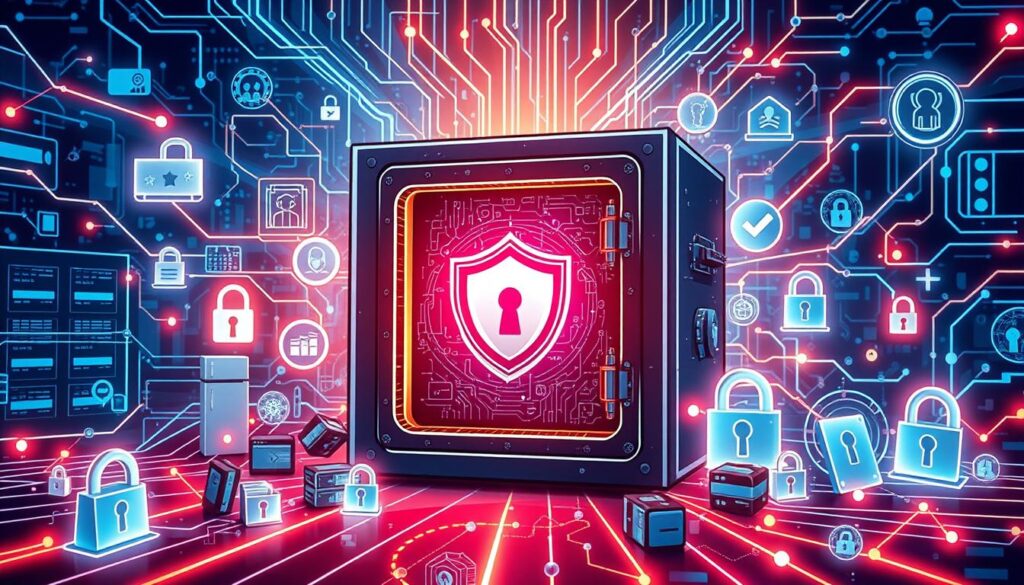Did you know over 60% of companies have faced cyberattacks in the last year? This shows how important security operations are today. CISSP Domain 7 deals with Security Operations. It includes things like handling incidents, watching for threats, and setting up security measures.
Learning about CISSP Domain 7 is key for anyone serious about cybersecurity. This guide will help you understand why CISSP Domain 7 is so important. You’ll see how it helps meet industry standards.
Key Takeaways
- CISSP Domain 7 emphasizes the importance of security operations for risk management.
- Understanding incident response and monitoring is crucial for protecting assets.
- Key topics within the CISSP domain 7 topics include digital forensics and continuous monitoring.
- Effective security operations can greatly reduce the impact of cyber threats.
- Utilizing tools like SIEM can enhance security event analysis.
- Mastering the CISSP 7th domain is a vital step for cybersecurity professionals seeking certification.
Understanding Security Operations in CISSP Domain 7
CISSP domain 7 focuses on security operations, a key part of keeping an organization safe. It covers many processes to protect information assets. Knowing these operations is crucial for setting up strong security measures.
Importance of Security Operations
Security operations in CISSP domain 7 are very important. This area makes up about 13% of the CISSP exam, showing its big role in cybersecurity. It includes incident management, vulnerability management, and more, all aimed at keeping threats away.
One key part is threat intelligence, added in 2021. It involves using threat feeds and threat hunting to lower risks. Also, user and entity behavior analytics (UEBA) checks user and system behavior to spot oddities, helping in security.
Good security operations need strong incident management. This includes detecting, responding, and fixing security issues quickly. It’s also important to have solid disaster recovery plans and test them often.
Other important things include managing backups and using SIEM tools to analyze security data. These steps help organizations stay ready for new threats.
Key Concepts in CISSP Domain 7: Security Operations
Getting to know CISSP domain 7 is key for those in security operations. This domain covers important principles to protect assets. Learning these concepts helps in keeping information systems safe, reducing risks, and building a strong security culture.
Core Components of Security Operations
Several key components shape the world of security operations. Mastering these areas helps a lot in improving an organization’s security.
- Frameworks for Security Operations: Many frameworks guide security practices, offering a structured way to implement security measures.
- Risk Analysis: Finding potential threats and weaknesses helps organizations focus their security efforts.
- Threat Modeling: This method assesses threats to help design secure systems and decide where to allocate resources.
- Incident Management: A good incident management process prepares organizations to quickly respond to security breaches, reducing damage.
- Continued Monitoring: Regular checks and alertness help organizations stay ahead of security gaps and new threats.
Using these core security concepts in daily work helps organizations not just react to incidents but also prevent them. This approach makes security a shared responsibility in the organization.
CISSP Domain 7 Topics You Need to Know
To understand CISSP domain 7 well, you must learn about security operations. This knowledge helps protect an organization’s assets. Knowing these key areas makes you better at using CISSP domain 7 knowledge:
Relevant Topics in Security Operations
- Security monitoring and logging
- Incident response planning and execution
- Service Level Agreements (SLAs)
- Business continuity planning and disaster recovery
Learning these subjects gives you a deep understanding of security operations. It helps protect an organization from cyber threats. This knowledge leads to better security and proactive strategies in cybersecurity.
| Topic | Description | Importance |
|---|---|---|
| Security monitoring and logging | Tracking and analyzing security events in real-time. | Critical for detecting and responding to threats promptly. |
| Incident response planning and execution | Preparation and execution of responses to security incidents. | Ensures effective handling of breaches to minimize impact. |
| Service Level Agreements (SLAs) | Formal agreements defining service expectations between entities. | Establishes clear performance and security standards. |
| Business continuity planning and disaster recovery | Strategies for maintaining operations during disruptions. | Essential for resilience in the face of disasters. |
Knowing these topics helps you manage security operations well. It strengthens your skills in CISSP domain 7 knowledge.
Incident Response and Management in Security Operations
Incident response management is key in security operations, especially in CISSP domain 7. It helps organizations handle security incidents well. This approach reduces damage and gets things back to normal quickly.
Steps in Incident Response
Effective incident response has several important steps. Each step helps guide the organization through a security breach. Here’s a detailed look at these essential steps:
- Preparation: Create and update your incident response plans. Training your team and having the right resources ready is crucial.
- Detection and Analysis: Spot and study security incidents as they happen. This phase focuses on finding signs of trouble and judging how serious they are.
- Containment: Act fast to limit the damage. This might mean isolating systems or networks to stop further harm.
- Eradication: Get rid of the cause of the incident. This might involve fixing software or changing settings.
- Recovery: Make sure systems work again and fix any weaknesses before they go back online.
- Post-Incident Review: Look back at the incident and how you responded. Learn from it and plan better for the future.
Knowing each step in incident response is vital for a good plan. It helps protect your organization and prepares you for security challenges.

| Step | Description | Objectives |
|---|---|---|
| Preparation | Establish protocols and prepare the team. | Readiness for incidents. |
| Detection | Identify anomalies and security incidents. | Recognize threats early. |
| Containment | Limit the impact of the incident. | Prevent escalation. |
| Eradication | Remove threats from the environment. | Eliminate vulnerabilities. |
| Recovery | Restore systems and verify functionality. | Resume normal operations. |
| Post-Incident Review | Analyze and document the incident. | Improve future response efforts. |
Security Operations Center (SOC) Functions
A Security Operations Center (SOC) is key in any organization. It watches, finds, and fixes security problems. Knowing what a SOC does is crucial for CISSP domain 7. It brings together many tasks to manage threats and handle incidents well.
Role of SOC in Security Operations
The SOC is vital for keeping an organization safe. It does many things, like:
- Threat Intelligence Gathering: It collects and studies threat data to help prevent problems.
- Incident Management: It quickly responds to security issues to lessen harm and get things back to normal.
- Compliance Oversight: It makes sure the organization follows laws and rules about protecting data.
- Risk Assessment: It checks for weaknesses and finds ways to reduce risks.
These tasks help organizations deal with new threats better. A good SOC watches things closely and acts fast to stop breaches. It’s a key part of any security plan.
| Function | Description |
|---|---|
| Threat Intelligence Gathering | It finds potential threats early by analyzing data. |
| Incident Management | It manages responses to security threats to reduce risks and data loss. |
| Compliance Oversight | It checks if the organization follows cybersecurity laws, making sure it’s legal. |
| Risk Assessment | It finds weaknesses in systems and comes up with ways to fix them. |
CISSP Domain 7 Knowledge Areas
Understanding CISSP Domain 7 is key for security operations. It covers specific areas that boost your grasp of security. The seventh domain includes various topics that help you manage security well.
Knowing these areas helps you create strong security solutions. It’s all about mastering the skills for effective security management and teamwork.
Comprehensive Knowledge Areas for Security Operations
Here are the main knowledge areas in CISSP Domain 7 for security pros:
- Security Principles: Knowing the basics is crucial for solid operations.
- Risk Management Strategies: It’s important to understand how to handle risks to protect assets.
- Incident Response Mechanisms: Good response plans help manage security incidents well.
- Regulatory Standards Compliance: Knowing industry rules keeps you compliant and avoids legal trouble.
- Data Analysis Skills: Using data tools helps you understand security data better.
The table below shows what you need for senior roles tied to CISSP domain 7:
| Qualifications | Description |
|---|---|
| Bachelor’s Degree in STEM | Important for grasping technical security aspects. |
| Advanced IA Certification | Certifications like CISSP show you’re an expert in security. |
| Top Secret Clearance | Needed for jobs in sensitive areas, especially with the U.S. Government. |
| Experience in Data Visualization | Knowing tools like Tableau for security data analysis. |
| Statistical Analysis Skills | Using stats on big data to make informed decisions. |
Using CISSP domain 7 knowledge well helps you tackle challenges. It makes your work environment more secure.

Best Practices for Security Operations
It’s key to follow CISSP domain 7 best practices for strong security operations. These practices boost your organization’s defense against threats. They also make sure you follow important rules. Knowing the right steps can greatly improve your security.
Effective Strategies for Enhancing Security
Keeping your information safe needs a mix of smart strategies. Important steps include:
- Continuous Training: Keeping your team’s skills up to date helps fight off threats.
- Regular Security Audits: Audits find weak spots and check if you follow security rules.
- Comprehensive Incident Response Plans: Good plans help act fast when security is breached.
- Utilization of Security Automation Tools: Tools that do tasks for you make things smoother and cut down on mistakes.
- Fostering a Culture of Security Awareness: Getting everyone to see their part in security makes your whole team stronger.
Using these CISSP domain 7 best practices makes your security work better. It’s important to match these strategies with your company’s goals for a solid risk management plan.
Preparation Tips and CISSP Domain 7 Study Guides
Getting ready for CISSP Domain 7 needs a careful plan to learn well. Using detailed CISSP domain 7 study guides is key. These guides cover important topics and use real-world examples to help you understand security operations better.
Strategies for Effective Study
Here are some tips to help you study well:
- Develop a Study Plan: Make a schedule to cover each topic in Domain 7.
- Engage with Interactive Training: Hands-on training helps solidify your grasp of concepts.
- Utilize Practice Exams: Practice tests help you see what you know and what you need to work on.
- Join Study Groups: Working with others can help you understand tough topics better and share resources.
- Allocate Self-Study Hours: Set aside at least 40 hours for self-study to really get the material.
The CISSP exam is 4 hours long and has 125 to 175 questions. So, practicing time management is very important. Also, know the costs, like about €665 for the exam and €4,250 for the 7-day prep course.
Sticking to these preparation tips for CISSP will greatly help you on your path to certification. Remember, ISC2 needs at least 5 years of work experience in two or more CISSP domains. Use your current knowledge and studies together.
Conclusion
Mastering CISSP Domain 7 is key to your success in security operations. This domain teaches you essential security practices to protect assets. Knowing core concepts, incident response, and best practices helps you tackle cybersecurity threats.
Continuous learning and adapting in security operations are crucial. Keeping up with new threats and technologies keeps you competent. Using what you learn from this domain can improve your organization’s security.
Your role as a security professional is vital in protecting critical infrastructures. By following these practices and improving your knowledge, you’ll be ready for today’s security challenges.
FAQ
What is CISSP Domain 7 focused on?
CISSP Domain 7 is all about Security Operations. It covers important areas like incident response, monitoring, and security controls. It’s key for managing risks and following industry standards.
Why are security operations important?
Security operations are crucial for keeping information safe. They help spot, handle, and fix security issues. This keeps the organization’s data secure.
What key topics should I study in CISSP Domain 7?
You should focus on security monitoring, incident response, and Service Level Agreements (SLAs). Also, studying business continuity and disaster recovery is vital. These topics give a full view of security operations.
What are the main steps in incident response as per CISSP Domain 7?
Incident response has several steps. First, you prepare and then detect and analyze the issue. Next, you contain and eradicate the threat. After that, you recover and review what happened. Each step helps manage and lessen the impact of a security breach.
What is the role of a Security Operations Center (SOC)?
The SOC is at the heart of an organization’s cybersecurity. It watches for threats, detects them, and acts fast. It also gathers threat intelligence and manages incidents.
What knowledge areas are included in CISSP Domain 7?
CISSP Domain 7 covers security basics, risk management, incident response, and regulatory knowledge. These areas are vital for creating strong security plans.
What are some best practices for security operations?
Good practices include ongoing training and regular security checks. Having solid incident response plans and using automation tools are also key. Creating a security-aware culture in your organization is important too.
How should I prepare for CISSP Domain 7?
To get ready for CISSP Domain 7, use reliable study materials and join interactive training. Practice with exams and make a study plan. Studying with others can help you learn and remember better.
Source Links
- Insights into CISSP Domain 7: Security Operations
- CISSP Self-Study Resources: Top Guides and Materials
- CISSP domain 7: Security operations — What you need to know for the exam [Updated 2022]
- CISSP Certification Domain 7: Security Operations – LocknLogin
- Cognitive Warfare (CW) & Strategic Communications (StratComs)
- Helping to Secure Our World: 2024 Internet2 Opportunities for the Research & Education Cybersecurity Community
- 10 Types of Machine Learning Algorithms and Models
- 20+ IT Certifications with the Highest Pay
- The CISSP Endorsement Process: How to Validate Your Cybersecurity Expertise
- ² Guide to the CISSP CBK PDF
- CISSP Certified Information Systems Security Professional
- Top 50 Cyber Security Interview Questions and Answers in 2024
- Top Cybersecurity Interview Questions and Answers for 2025
- Comparison of CISSP and 2 Other Security Certificates. Which One is More Valuable in Japan?
- Data Science Cyber Systems Engineer at TENICA Global Solutions – Springfield, VA
- Top Cybersecurity Certifications You Should Know About as a Developer
- CISSP® Preparation Course – Security Academy Online
- 5 Best Programming Languages for Hacking in 2025 | Simplilearn
- How to Conduct a Feasibility Study: Key Steps & Examples
- Top Spring Boot Interview Questions and Answers [2025]
Related posts:
 CISSP Domain 3: Security Architecture and Engineering
CISSP Domain 3: Security Architecture and Engineering
 CISSP Domain 4: Communication and Network Security
CISSP Domain 4: Communication and Network Security
 What is ARP? The Address Resolution Protocol Explained
What is ARP? The Address Resolution Protocol Explained
 Access Control Concepts: Safeguarding Systems and Data in Cybersecurity
Access Control Concepts: Safeguarding Systems and Data in Cybersecurity
 Big Data Analytics Trends and Applications in Industry
Big Data Analytics Trends and Applications in Industry
 CISSP Domain 1: Security and Risk Management Guide
CISSP Domain 1: Security and Risk Management Guide









